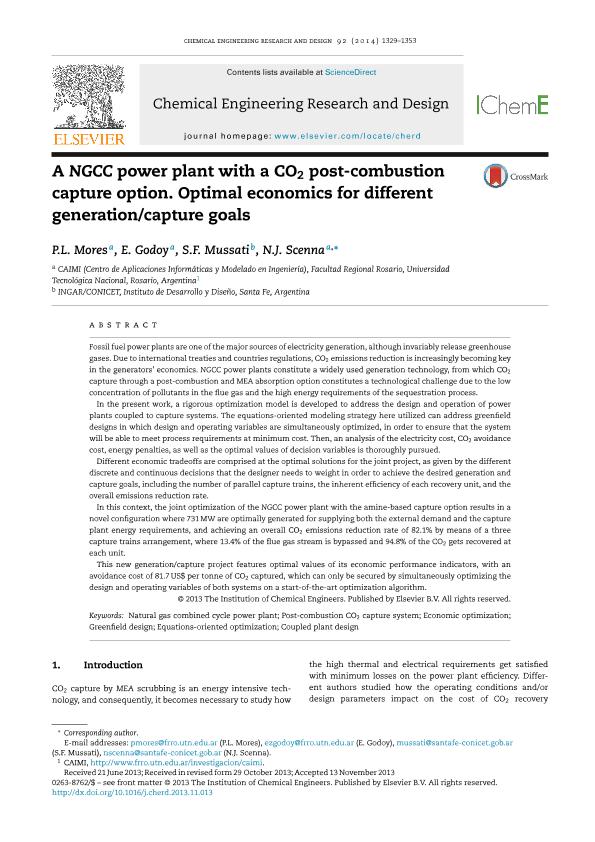Mostrar el registro sencillo del ítem
dc.contributor.author
Mores, Patricia Liliana

dc.contributor.author
Godoy, E.
dc.contributor.author
Mussati, Sergio Fabian

dc.contributor.author
Scenna, Nicolas Jose

dc.date.available
2016-09-06T15:27:13Z
dc.date.issued
2014-07
dc.identifier.citation
Mores, Patricia Liliana; Godoy, E.; Mussati, Sergio Fabian; Scenna, Nicolas Jose; A NGCC power plant with a CO2 post-combustion capture option. Optimal economics for different generation capture goals; Inst Chemical Engineers; Chemical Engineering Research & Design; 92; 7; 7-2014; 1329-1353
dc.identifier.issn
0263-8762
dc.identifier.uri
http://hdl.handle.net/11336/7475
dc.description.abstract
Fossil fuel power plants are one of the major sources of electricity generation, although invariably release greenhouse gases. Due to international treaties and countries regulations, CO2emissions reduction is increasingly becoming key in the generators? economics. NGCC power plants constitute a widely used generation technology, from which CO2capture through a post-combustion and MEA absorption option constitutes a technological challenge due to the low concentration of pollutants in the flue gas and the high energy requirements of the sequestration process. In the present work, a rigorous optimization model is developed to address the design and operation of power plants coupled to capture systems. The equations-oriented modeling strategy here utilized can address greenfield designs in which design and operating variables are simultaneously optimized, in order to ensure that the system will be able to meet process requirements at minimum cost. Then, an analysis of the electricity cost, CO2avoidancecost, energy penalties, as well as the optimal values of decision variables is thoroughly pursued. Different economic tradeoffs are comprised at the optimal solutions for the joint project, as given by the different discrete and continuous decisions that the designer needs to weight in order to achieve the desired generation and capture goals, including the number of parallel capture trains, the inherent efficiency of each recovery unit, and the overall emissions reduction rate. In this context, the joint optimization of the NGCC power plant with the amine-based capture option results in a novel configuration where 731 MW are optimally generated for supplying both the external demand and the capture plant energy requirements, and achieving an overall CO2emissions reduction rate of 82.1% by means of a three capture trains arrangement, where 13.4% of the flue gas stream is bypassed and 94.8% of the CO2gets recovered at each unit. This new generation/capture project features optimal values of its economic performance indicators, with an avoidance cost of 81.7 US$ per tonne of CO2captured, which can only be secured by simultaneously optimizing the design and operating variables of both systems on a start-of-the-art optimization algorithm.
dc.format
application/pdf
dc.language.iso
eng
dc.publisher
Inst Chemical Engineers

dc.rights
info:eu-repo/semantics/openAccess
dc.rights.uri
https://creativecommons.org/licenses/by-nc-nd/2.5/ar/
dc.subject
Natural Gas Combined Cycle Power Plant
dc.subject
Post-Combustion Co2capture System
dc.subject
Economic Optimization
dc.subject
Greenfield Design
dc.subject
Equations-Oriented Optimization
dc.subject
Coupled Plant Design
dc.subject.classification
Ingeniería de Procesos Químicos

dc.subject.classification
Ingeniería Química

dc.subject.classification
INGENIERÍAS Y TECNOLOGÍAS

dc.title
A NGCC power plant with a CO2 post-combustion capture option. Optimal economics for different generation capture goals
dc.type
info:eu-repo/semantics/article
dc.type
info:ar-repo/semantics/artículo
dc.type
info:eu-repo/semantics/publishedVersion
dc.date.updated
2016-08-01T18:37:20Z
dc.journal.volume
92
dc.journal.number
7
dc.journal.pagination
1329-1353
dc.journal.pais
Países Bajos

dc.journal.ciudad
Amsterdam
dc.description.fil
Fil: Mores, Patricia Liliana. Universidad Tecnologica Nacional. Regional Rosario. Centro de Aplicaciones Informaticas y Modelado En Ingenieria; Argentina
dc.description.fil
Fil: Godoy, E.. Consejo Nacional de Investigaciones Científicas y Técnicas; Argentina. Universidad Tecnologica Nacional. Regional Rosario. Centro de Aplicaciones Informaticas y Modelado En Ingenieria; Argentina
dc.description.fil
Fil: Mussati, Sergio Fabian. Consejo Nacional de Investigaciones Científicas y Técnicas. Centro Científico Tecnológico Santa Fe. Instituto de Desarrollo y Diseño (i); Argentina
dc.description.fil
Fil: Scenna, Nicolas Jose. Universidad Tecnologica Nacional. Regional Rosario. Centro de Aplicaciones Informaticas y Modelado En Ingenieria; Argentina
dc.journal.title
Chemical Engineering Research & Design

dc.relation.alternativeid
info:eu-repo/semantics/altIdentifier/url/http://www.sciencedirect.com/science/article/pii/S0263876213005029
dc.relation.alternativeid
info:eu-repo/semantics/altIdentifier/doi/http://dx.doi.org/10.1016/j.cherd.2013.11.013
Archivos asociados
